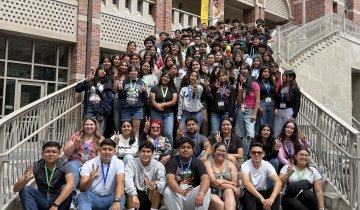‘Equity’ has become a buzzword in education, but what does it mean for current and aspiring professionals in the industry?
As part of our blog series on equity in education, some of the thought leaders at USC Rossier present their point of view on the topic. (Check out our posts on gender equity and economic equity.)
First up: Estela Mara Bensimon talks about the role of race.
Bensimon is The Dean’s Professor in Educational Equity and Director of USC Rossier’s Center of Urban Education (CUE). She has published extensively about racial equity, held various leadership positions, and received grants from the Ford Foundation, the Bill and Melinda Gates Foundation, and more.
(Curious about USC Rossier’s mission to promote equity in education? Learn more about our graduate programs.)
Whether you’re a leader, administrator or teacher, here are Bensimon’s insights about equity as it pertains to race.
What is racial equity?
Racial equity is corrective justice for communities that have suffered oppression through enslavement (African Americans), genocide (Native Americans), colonization (Puerto Rico and Hawaii), and theft of territory (Mexican Americans).
According to Bensimon, equity seeks reparation for those who are denied the same opportunities as whites due to a long history of legislated (e.g., Jim Crow) and institutionalized racism (e.g, definitions of merit that advantage whites).
In education, teachers and administrators may not realize there is an equity problem because of the biases that exist in their education, training and upbringing. This can affect student outcomes, teacher performance, curriculum, admission practices and more.
Equity focuses on “dismantling whiteness.” Whiteness is a culture of values that favor white people at the expense of others. In education, it prevents historically marginalized students from reaching their potential, and professionals from advancing in their career.
(Rather than “historically marginalized”, Bensimon also uses the word “minoritized” to emphasize that people of color do not become minorities of their own accord.)
Check out these seven key takeaways about equity in education.
1. Equity is intertwined with race
While equity is a trending topic in education, the word is often misused, according to Bensimon.
In a post on CUE’s website, she wrote, “I now see [equity] in initiatives, articles, and proposals. I hear it in presentations, reports, and speeches. A term that was once viewed as divisive, particularly when associated with racial justice, has become commonplace.”
However, in its current usage, equity is disconnected from its racial justice roots. Schools recognize that they need to include it in policies, but there’s insufficient action behind it. As a result, a culture of whiteness continues to persist. To really invest in equity, schools need to become equity-minded, audit their own practices, and if needed, revise them to be more race conscious.
2. Inequity is institutional
The reason that inequity may be a bigger challenge than many schools realize is that academia has blindspots. “We’ve been socialized to think academia is a place that is race neutral,” said Bensimon.
Research may partially be to blame. When evaluating student success, researchers tend to regard race as a variable, not an experience or political condition. Or they may ignore it altogether.
Shifting the focus of research could be helpful. Currently, researchers study students to understand how their motivation correlates to academic success. But little research is done on faculty. By surveying teachers’ beliefs and practices, we can better understand how their views on race impact educational outcomes.
3. Teachers help—and hurt—equity
Bensimon notes that evidence shows white students are more likely to speak out in class than students of color. Most teachers aren’t taught to be racially literate. They don’t know how their practices might reinforce inequalities.
However, teachers can promote equity by being more race-conscious. For example, by addressing how a syllabus reflects the experiences of black or Latinx students, they can reach those who may be alienated by traditional curriculum.
Another useful way for teachers to become more equity-minded is to adopt a “first-generation” perspective. First-generation college students of color may have been deprived of the same level of preparation for college as other students.
Similarly, white teachers may not be aware of the challenges of historically minoritized students because they lack the appropriate preparation to teach them. They may also attribute lack of success to deficiencies that they associate with students of color.
4. Graduate programs can train equity-minded leaders
“It’s important to develop leaders of equity-minded competency,” said Bensimon. To that end, graduate programs in education can be a useful tool. Ideally, students graduate from their master’s or doctoral programs ready to drive equity at senior levels of their organization. However, be diligent when doing your research as not all programs are equipped to accomplish this task.
To properly train future practitioners and leaders, the school’s mission should expressly state a commitment to equity, and curriculum needs to be self-conscious about race. “Courses need to address whiteness as an institutional characteristic,” she added. The takeaway? Find out if your master’s or doctoral program aligns with your interest in advancing equity.
5. Equity is not the same as diversity
In education, equity and diversity are sometimes used interchangeably, but they have some significant differences. While well-intentioned, the initiative to promote diversity in schools has the ironic effect of “whitewashing” equity.
Diversity seeks to increase representation of historically marginalized students, faculty and administrators. However, often it doesn’t focus on correcting the central issue: racial injustice. Equity aims to fix the systemic conditions that cause the exclusion of students of color in education.
6. Persuade leadership with data
If you’re an administrator, how do you convince top leadership that racial inequity in education is a major issue? Bensimon suggested using data. Research shows that historically marginalized students perform better when they have same-race teachers.
Similarly, economics can be persuasive. For example, Latinos now outnumber whites as the largest ethnic group in California. The wealth of the state depends in part on their educational attainment. Therefore it’s in academia’s best interest to create more equitable learning environments.
7. Academia has room for improvement
While academia has made strides in its effort to promote equity in education, it still has a long way to go. Bensimon highlighted deeply-rooted problems such as coded language. Words like “merit” and “fit” are sometimes used in the hiring process in ways that discriminate against candidates of color or female candidates.
Systemic problems may take a long time to fix, but there are more actionable methods of advancing equity that can be implemented in the short term by leadership:
- Acknowledge that equity is rooted in racial justice
- Incentivize admitting and graduating students of color
- Value work by faculty done on behalf of racial equity
- Hire more faculty of color and faculty who are equity-minded
- Prioritize hiring first-generation faculty who are also people of color
USC Rossier resources
USC Rossier is committed to promoting equity in education. Request information about our graduate programs.
You can also explore CUE’s website to review research initiatives, read published works, and access actionable tools.




